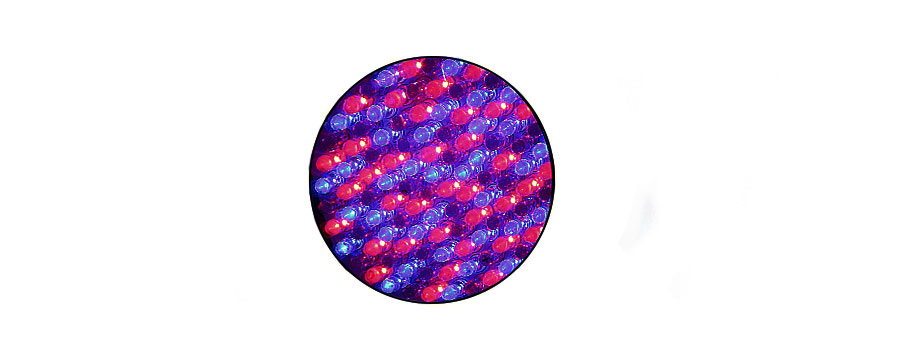WHAT TO LOOK FOR WHEN CHOOSING AN LED GROW LIGHT 2020
Before you buying an LED grow light, it helps to know what’s available. Currently, there are three main types of LEDs that you can use to grow cannabis, each of which has its pros and cons. The type of LED light you should choose will depend on what exactly you’re looking for, and how much money you’re willing to spend.
3 MAIN TYPES OF LED GROW LIGHTS
- STANDARD (“PURPLE”) LED

These standard LED light fixtures were the first type available for growing, and today, they’re still widely available. These lights contain a lot, sometimes hundreds, of small to medium wattage LEDs (3–5 watts per single LED) in a compact fixture. Cannabis growers sometimes refer to these as “purple” lights, as they often comprise a mix of red and blue LEDs that combine to emit a purple hue. The biggest advantage of these standard LED lights is their price point. Most are manufactured overseas, and you can find them aplenty on eBay and other places online. A disadvantage is that their quality is often lacking; they can be less than reliable, and their light output is often lower than other types of LEDs, leading to lower yields. To remedy this, we’re now seeing standard LEDs begin to include COB LED lights or UV LEDs in addition to the red and blue, which can help with yield and bud quality.
- COB LED

COB means “chip on board”. A COB LED is made of many hundreds of tiny LEDs on one single small chip, as opposed to differently coloured LEDs spread over the entire fixture (as is the case above). COBs are among the most efficient LEDs. They produce a very intense white light that is similar to the natural light spectrum of the sun. One advantage of COBs is that they have good penetration into the plant canopy due to their intensity, resulting in a final yield approaching that of quality HID lamps. They also have a light spectrum that is optimal for healthy growth, and are very energy-efficient. The drawback can be that a quality grow light with COB LEDs is quite expensive compared to cheaper purple lights. Some grow light manufacturers combine several COB LEDs into one fixture, often equipping them with lenses and reflectors. There are also lights available that are comprised of only one single COB. These single-COB fixtures can be a good choice for larger growing spaces, as you can space a number of them evenly for light distribution across the entire area. Most growers use COB LEDs with a light spectrum that works both for vegging and flowering, but you can also find those with a spectrum (“colour temperature”) tuned specifically to vegging or flowering.
SPREAD-STYLE LED

Spread-style LEDs are comprised of a large number of small LEDs that are spread out on a larger panel or board. There are also spider-style LEDs and rack-style LED lights, which are widely used in commercial greenhouses. The spider-style LED lights don’t use flat panels, but spider-like “arms” with LEDs instead. The main advantage of spread-style grow lights is that they are among the most energy-efficient LEDs, which means you can get the most light for the wattage you’re using. A disadvantage is that quality spread-style LEDs, such as the spider-style lights, can be extremely expensive.
THE ADVANTAGES OF GROWING WITH LED LIGHTS
We’ve already mentioned that LED lights have several advantages when compared to other types of grow lights, such as HID. Here is a full rundown of why you may want to choose LEDs for your next growing operation.
1. LED LIGHTS ARE MORE ENERGY-EFFICIENT
Compared to HID lights, LEDs are a lot more energy-efficient. They use less electricity, and will cost much less to operate in the long-run. Although high-end LED lights can sometimes cost a good chunk of money outright, the investment is almost always worth it as your savings over time will make up for the higher initial cost. Likewise, quality LED light fixtures will also have a longer life span compared to HID, the latter of which tends to lose performance over time and needs frequent replacement. A good LED light can last you many years with no maintenance needed.
2. THEY RUN COOL
LEDs produce a lot less heat compared to HID lights, which can be a big advantage as you won’t require extra cooling systems in your grow room or tent to keep temperatures optimal. This is especially advantageous if you grow in summer or happen to live in a warmer climate. The downside to this is that if you live somewhere cold, you may now need to consider a heater in the colder months. But as LEDs save you money over time, this can make up for the potential costs of running a heater.
3. WITH LED, YOU CAN MOVE YOUR PLANTS CLOSER TO THE LIGHT
LEDs produce less heat, which means less stress on your plants—so you can move your lights closer to your plants without any negative effects. Higher light intensity translates to higher

Comments
Post a Comment